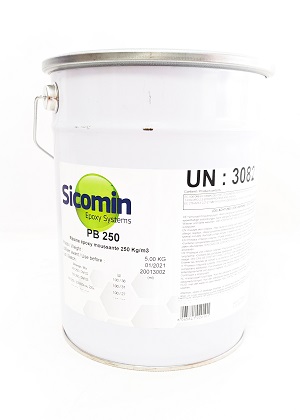Product Description
EPOXY FOAM 250 5 KG, RESIN COMPONENT 250 KG/M3
Epoxy foam expands more slowly than polyurethane foam and offers excellent adhesion to nearly all materials. It also has exceptionally low water absorption. Typical applications include boat keels and rudders, filling voids in sandwich laminate construction, and repairing sandwich structures.
The foam is available in densities of 170 kg/m³ and 250 kg/m³, with two different hardeners. The slow hardener is recommended for thicker castings to prevent excessive reaction heat (e.g., > 50 mm). Epoxy foam is also available in larger batches as a three-component system, allowing you to adjust the foam density yourself. More information is available on request.
Mixin Ratio: | |
5 kg resin + 1.55 kg standard hardener | 100 : 31 |
5 kg resin + 1.8 kg slow hardener | 100 : 36 |
Epoxy foam is also available in larger containers.
Instructions for Use
1. Measure the volume of the cavity to calculate the correct amount of mixture.
2. Pre-mix both components separately to eliminate any settlement that may have occurred during storage.
3. Accurately measure the required quantities using a precise scale or syringe.
4. Mix components thoroughly, scraping the sides and bottom of the container. The mixture must be poured within 4 minutes.
To reduce mixing-related air bubbles, pour the mixture through a sieve into the area to be foamed. This produces a more homogeneous foam structure.
The foam expands quickly, but full curing takes several hours. Once cured, the foam is hard but relatively brittle; final strength develops over time. For best performance, post-cure the foam after room-temperature curing at approx. 40°C for 6 hours (e.g., overnight in a warm room or sauna). After post-curing, the structure becomes strong, durable, and water-resistant.
Safety
Always ensure good ventilation and adequate skin protection when working with epoxy. Wear long sleeves and disposable gloves resistant to epoxy (e.g., nitrile). Uncured epoxy resin is a strong skin sensitizer. A suitable respirator for epoxy work is certified according to EN405. Fully cured epoxy is non-hazardous.
Tools may be cleaned with acetone, but note that epoxy adheres extremely well to almost all surfaces — including tools. Use inexpensive tools you can dispose of after use.
Hardener
Harmful if swallowed or in contact with skin. Causes severe skin burns and serious eye damage. May cause an allergic skin reaction. May damage organs through prolonged or repeated exposure (if swallowed). Toxic to aquatic life with long-lasting effects.
Resin
Causes skin irritation. May cause an allergic skin reaction. Causes serious eye irritation. Toxic to aquatic life with long-lasting effects.


